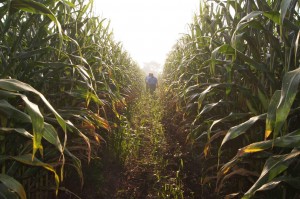The Ethicurean: Chew the right thing. –
 Just about any road I take that leads me out of Wooster, Ohio, very quickly guides me past vast fields of corn or soybeans. Agriculture plays a vital role in Wayne County’s economy, and for several decades now, commodity crops have contributed more than their fair share to our local economy. Smaller farms that emphasize fruits and vegetables (so-called “specialty” or “differentiated” crops) are harder to spot on a drive down a country highway, but these farms have started to make a larger impact on the Wayne County agricultural scene.
Just about any road I take that leads me out of Wooster, Ohio, very quickly guides me past vast fields of corn or soybeans. Agriculture plays a vital role in Wayne County’s economy, and for several decades now, commodity crops have contributed more than their fair share to our local economy. Smaller farms that emphasize fruits and vegetables (so-called “specialty” or “differentiated” crops) are harder to spot on a drive down a country highway, but these farms have started to make a larger impact on the Wayne County agricultural scene.
Not surprisingly, though, given the state of discourse on food and farming today, these two groups of farmers don’t often come together to talk about farming – or when they do, both sides can bring a little defensive tension to the conversation. It’s easy to criticize the commodity farmers for perpetuating a monoculture of chemical-dependent crops, just as it’s easy to deride the small farmer for engaging in a labor-intensive form of agriculture that can’t possibly “feed the world.”
Underlying those extreme sentiments, however, it’s also easy to see that farmers of any stripe are struggling to maintain their livelihoods when there is little true social or financial support for their work.
So what would happen if you could get both a commodity farmer and a specialty crop farmer to drop their defenses, talk to each other, and find a way to work together? That was the question raised at last year’s Stinner Summit, an annual roundtable sponsored by the Agroecosystems Management Program at Ohio State’s Ohio Agricultural Research and Development Center and funded by the Ben Stinner Endowment for Healthy Agroecosystems and Sustainable Communities. Each year, the Summit brings together a variety of people interested in promoting local and sustainable agriculture in an effort to develop and fund projects that will explore and promote local food systems in Ohio. The 5th Annual Stinner Summit is on October 7.
Polyamory or Pollyanna?
At last year’s fourth Summit, the question of bringing together farmers of different crops to find common ground led to the development of the Poly-farming Project.
During the course of the discussion, one participant pointed out that research had found that corn yields, dependent on exposure to sunlight, were increased in fields where more edges of the crop were given full sunlight. By revisiting the method of strip cropping and interplanting corn or soy with strips of specialty crops, the summit participants outlined an experiment to allow a commodity farmer to work with a specialty crops producer, sharing space and ideas without decreasing yields for either farmer. The potential benefits of such collaboration guided the discussion:
- enhance dialogue between farmers who emphasize economies of scale and those who focus on economies of scope and differentiated crops
- diversify income sources for commodity producers by renting land to the specialty crop farmer
- provide new farmers affordable access to land
- enable the sharing of tools and machinery, making more efficient use of investments
- provide the opportunity to share knowledge and experience
- increase crop diversity
- create new opportunities for ecologically-based pest and soil fertility management
- increase availability and variety of locally grown foods
- increase investment in the local community
- promote increased biodiversity, ecological health, soil nutrient management
 For the 2011 growing season, the Agroecosystems Management Program organized one test farm for the Poly-farming Project. Roger Gwin, a corn and soy farmer near Shreve (south of Wooster), agreed to vary his tilling and planting patterns in order to make room for two specialty crop farmers: Brian Gwin, his son and Project Manager for the Wayne Economic Development Council, and Bill Boyer, teacher, farmer, and founding member of Local Roots Market and Café. Gwin allotted two acres out of his 700-acre farm for the project’s use, creating precise strips (covering about 1/10th of an acre) for different varieties of melons, potatoes, squash, peanuts, peppers, a cover crop of buckwheat, and edamame. An additional strip provided space for a cover crop of radishes to test the future possibility of in-field mobile poultry units.
For the 2011 growing season, the Agroecosystems Management Program organized one test farm for the Poly-farming Project. Roger Gwin, a corn and soy farmer near Shreve (south of Wooster), agreed to vary his tilling and planting patterns in order to make room for two specialty crop farmers: Brian Gwin, his son and Project Manager for the Wayne Economic Development Council, and Bill Boyer, teacher, farmer, and founding member of Local Roots Market and Café. Gwin allotted two acres out of his 700-acre farm for the project’s use, creating precise strips (covering about 1/10th of an acre) for different varieties of melons, potatoes, squash, peanuts, peppers, a cover crop of buckwheat, and edamame. An additional strip provided space for a cover crop of radishes to test the future possibility of in-field mobile poultry units.
While the growing season has not yet finished, the results are promising. By working out a planting schedule at the beginning of the season, the farmers had no problems juggling the maintenance of their respective crops. The specialty crop plots were tended by hand, but not at times when care of the commodity crops required the use of sprays or machinery in the field. The corn crops in the test field, in fact, were very carefully sprayed (by hand in some areas) to prevent any overlap on the specialty crops.
The first of the new crops – potatoes and edamame – have already been harvested and sold at Local Roots, and though pest and disease reduced the yields of some crops (mildew affecting the melon crop and potato bugs destroying many immature plants), the remaining crops should provide a decent harvest. Boyer discovered that, contrary to what might be expected from a field kept in the conventional corn and soy rotation, the soil in the specialty crop patches lacked compaction, unlike the more loamy soil on his home farm.
Coexistence and cooperation
Relatively few problems arose from the new arrangement, according to Brian Gwin. The corn crop suffered most from the wet planting season, and the space for the specialty crops saw a delay in tilling. Gwin also thought that the specialty crops “were likely more challenged” by the intercropping due to the shade cast by the corn crop, but he did see ways that those crops could be reorganized to make better use of underutilized acreage (especially in the case of vining fruits). He did point out, however, that adequate moisture in July and August – typically months when farmers are praying for rain – helped to produce good yields on the specialty crops. Boyer found that because he lives a few miles from Gwin’s farm, he did not get to the field regularly and thus lost track of the immediate needs of his crops, such as weeding or pest control.
 The impact on the individual farmers proved positive. Roger Gwin found value in the weed-suppressing qualities of the buckwheat cover crop and plans to plant an acre of it next year. He has also enjoyed the taste of fresh edamame, cooking it and taking it as a snack to local football games. Boyer appreciated the additional income from the Poly-farming crops sold at Local Roots, and though he recognized that his crops were “not always successful,” he has found that keeping better records about what was planted and grown this year will help him plan next year’s growing season with a better understanding of those crops’ needs.
The impact on the individual farmers proved positive. Roger Gwin found value in the weed-suppressing qualities of the buckwheat cover crop and plans to plant an acre of it next year. He has also enjoyed the taste of fresh edamame, cooking it and taking it as a snack to local football games. Boyer appreciated the additional income from the Poly-farming crops sold at Local Roots, and though he recognized that his crops were “not always successful,” he has found that keeping better records about what was planted and grown this year will help him plan next year’s growing season with a better understanding of those crops’ needs.
 Though this project involved only the one test field, researchers from the OARDC made use of the opportunity to examine several areas of results. The question of corn yields based on increased sunlight exposure, as mentioned earlier, was traced in one study, while another study evaluated the results from planting different cultivars of edamame. One graduate student was able to use a small section of the field for research on nematode movement between the grass border and potato plantings, and another kept track of the specialty crop yields as part of a larger research project. A couple of undergraduate students from the OARDC helped in the field throughout the season, giving them vital practical experience.
Though this project involved only the one test field, researchers from the OARDC made use of the opportunity to examine several areas of results. The question of corn yields based on increased sunlight exposure, as mentioned earlier, was traced in one study, while another study evaluated the results from planting different cultivars of edamame. One graduate student was able to use a small section of the field for research on nematode movement between the grass border and potato plantings, and another kept track of the specialty crop yields as part of a larger research project. A couple of undergraduate students from the OARDC helped in the field throughout the season, giving them vital practical experience.
So where will the project go from here? As Brian Gwin noted, “Everyone learned something this year and has a few theories and ideas for next season.” While the current field will revert to soybeans next year, the melon and edamame strips will probably be cover cropped over winter for additional experimentation and research. If the project continues at the Gwin farm next year, the farmers will plan to lay out the field slightly differently and give more consideration to selecting a corn variety that has a growing season more aligned with the specialty crops’ growth patterns. (Due to the late planting, the corn grown here this year was a short-season variety; a longer growing season might prove more adaptable to the needs of specialty crop maintenance.) Boyer considered that in future he would like to try growing a squash crop under a low tunnel to prevent pest damage, but as part of that experiment he hopes to place a beehive at the end of the tunnel with access to the crop as well as to the outside. And while he would consider planting different crops the next time around, Boyer decided he would repeat the peanut planting if only for his own enjoyment.
Pollination of ideas
 Graduate student Liz Kolbe (whose summary article in the Local Roots newsletter inspired a further look at poly-farming) helped initiate the project and is now involved in wrapping up this season and looking ahead to next year. While definite plans for the project’s future have not been set, she sees potential for an additional test field at the Mellinger Farm, a former corn-and-soy farm now owned by the OARDC for research purposes. If the project does continue there next year, says Boyer, he “would definitely do it again” since this farm lies only a mile down the road from his own.
Graduate student Liz Kolbe (whose summary article in the Local Roots newsletter inspired a further look at poly-farming) helped initiate the project and is now involved in wrapping up this season and looking ahead to next year. While definite plans for the project’s future have not been set, she sees potential for an additional test field at the Mellinger Farm, a former corn-and-soy farm now owned by the OARDC for research purposes. If the project does continue there next year, says Boyer, he “would definitely do it again” since this farm lies only a mile down the road from his own.
For now, though, the harvest continues and the farmers share their thoughts on this year’s crops and ideas for next year’s season. The idea behind Poly-farming was not to convert one farmer or another to the other’s way of doing things, and by bringing open minds to the table at the beginning of the project, these farmers learned a great deal from each other and began to appreciate and understand their common ground. As Bill Boyer put it, “You gotta start somewhere.”
Ohio farmers will want to check out this year’s Stinner Summit on Oct. 7, which will bring together new faces and old to share the results from the Poly-farming Project and to start new ways to promote sustainable agriculture – and sustainable ideas – in Ohio.
Photos courtesy of Liz Kolbe and Bob Recker.
(c) The Ethicurean: Chew the right thing. – Read entire story here.









